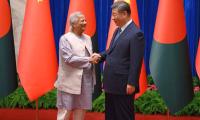 The roots of the problem lies in the alienation of the tribals. Extreme sensitivity is required to tackle the issues involved. Rough and ready methods of using force may prove counterproductive in the long run, says Colonel (retd) Anil Athale.
The roots of the problem lies in the alienation of the tribals. Extreme sensitivity is required to tackle the issues involved. Rough and ready methods of using force may prove counterproductive in the long run, says Colonel (retd) Anil Athale.
The ambush by Naxalites in Bastar area of Chhattisgarh on a convoy of Congress party men returning from a rally on Saturday has sent shock waves in that party and central government led by it. But the latest clarification by the Naxalites makes the issue clear. This was a revenge attack against two individual Congress leaders, Salwa Judum founder Mahendra Karma and state Congress chief Nand Kumar Patel, for their role in the anti-Naxal vigilante group and ‘Operation Green Hunt’ respectively.
This has clarified the issue somewhat as most of us were a little surprised as to why Naxals would target a party that has been pushing for a ‘soft line’ on Naxals. It is likely that the rebels feared that the party may come to power under these two and make life difficult for them. The elimination of these two leaders has left the field open for Ajit Jogi, known to favour a soft approach to Naxals. While there was much VIP tear shedding for Patel, Karma, died unsung. My tributes to Karma who was abandoned by his own party and even in death remained a victim of ‘left wing’ sway over his party.
But the casualness of the security provided to the victims and ‘apparent’ confidence of the Congressmen that they had nothing to fear, is both strange and callous. Even a total non VIP like this author was provided at least 10 soldiers for personal protection while moving in Manipur! This was in spite of the fact that whole route was manned by soldiers at 200 yards interval! When this author queried about this, he was told that this is ‘routine’ and Standard Operating Procedure for any movement.
In another instance, this time in Kashmir valley, one vividly recalls how a junior officer chided senior colonels of the army for violating convoy discipline! As per the army SOP all persons in a convoy have to obey the convoy commander, irrespective of their rank!
Time and again, the Indian police and para-military forces have failed to display professionalism and paid the price.
The Naxalite phenomenon is unique in many ways. Here is a movement of tribals led mostly by non-tribals from Telangana. Imagine Naga insurgents being led by Assamese or Kashmiri separatists led by Biharis? The truth is the Naxal revolutionaries, are not there to solve the problems of Adivasis. They are there as the forests offer sanctuaries for training and rest. The general neglect of the area, callous forest guards/police and power vacuum, made the task of the Naxals easy.
Once having helped the adivasis through their ‘Robin Hood’ methods, they now intend to milk the adivasi support for the ‘higher purpose’ of ushering the Marxist revolution throughout India.
The saddest part is that far too many arm chair ‘welfarists’ have been taken in by the pro-tribal rhetoric of Naxalites and never challenged the Naxal ideology.
The Salwa Judum or armed mobilisation of tribals by Karma to target the sangham (over ground sympathisers) members, hit at the weak point of the Naxals. Their meagre armed strength is useless without the sangham members and passive janata. The fact that all the top leaders of Naxals are non-tribals was a major factor in this breach between the two.
Mao had once famously said that the guerilla and popular support is like fish and water. Without the support of the masses the insurgent/guerilla cannot survive.
Alarmed at the erosion of popular support and fear of being isolated, the over ground wing of the Naxalites in cities and the capital New Delhi launched a fierce campaign against Salwa Judum. The media with its inherent leftist bias went to town over alleged atrocities by Salwa Judum members. The courts, human rights commission and civic activists were utilised to defame the resistance. It was dubbed as state government’s attempt to get tribals killed by tribals.
Everyone conveniently forgot that village defence forces being organised to fight rebels has a long history within India and outside. The central government with woolly-headed thinking and to get Naxal help in national elections ultimately succeeded in winding up the potent movement.
Emboldened by the ‘victory’ over Salwa Judum, the Naxals went about consolidating their hold over the forest areas and by 2010, were bold enough to take on the para-military forces in open confrontation. The May 27 incident is a logical culmination of the winding up of Salwa Judum and Operation Green Hunt.
Do the Naxals seriously believe that ‘revolutionary conditions’ as described by their guru, Che Guevara, really exist in India for their revolution to succeed? All this leads one to the conclusion that essentially the Naxals are a gang of thugs and robbers much on the lines of Sandalwood smuggler Veerappan, who also put up a charade of ‘Tamil pride’ to hide his criminal activities.
The roots of the problem lies in the alienation of the tribals on two counts -- one due to the unfair forest legislation, their natural habitat and second due to the glaring gap between the lifestyle and living standards of the tribals and plains men. Extreme sensitivity is required to tackle the issues involved. Rough and ready methods of using force may prove counterproductive in the long run.
Thus there is a dilemma of sorts, while urgency demands action sensitivity to tribal identity merits caution and preparation. What is needed is a completely new model of administration to be evolved based on sensitivity, realism and continuity. A re-look at erstwhile Indian Frontier Administrative Service like organisation may be worthwhile in light of our experience of repeated administrative failure in these areas.
Rule of law must replace the rule by the outlaw. Here the quality of administrator and law enforcer would matter a great deal. Tribals are war-like people and proud of being so. The history of Gonds and Santhals in resisting all manner of invaders should never be forgotten, nor their stand in support of the late Pravir Chandra Bhanjadeo (external link). In bringing the tribals to modernity care must be taken to be gradual and transition should not be from no clothes to a three-piece suit.
The three step approach to ideological conflicts is to contain-neutralise and reform. In this important aspect of the battle, media and communication (both verbal and non verbal) plays a major role The common perception of murgi chor (chicken stealing) soldiers or policemen do greater damage to the legitimacy of counter-insurgency than any amount of adverse propaganda.
In the heat of the battle there is a temptation to target the sympathisers for acts of violence by the armed insurgents. There is a major debate as to what agency/organisation must be used and for what task. There is a marked reluctance on the part of the armed forces to get involved in a domestic quarrel where there is no clear external element.
The para-military forces are expected to carry the major burden of fighting such wars. But there is a major problem here. At the level of section or platoon, where the guerrilla war is fought, these operations are in no way different than similar operations in conventional wars. The para-military forces are neither trained nor equipped to fight a war and are often found wanting. The principle of adequate force means that the armed forces cannot use their full range of equipment, a sort of fighting with one hand tied behind back. A way out of this dilemma is a middle path where in the armed forces act in support of the para-military.
For instance the searches and neutralisation may be carried out by the police, the armed forces lay the outer cordon to prevent escapes.
The South Africans faced a similar problem when they faced the African National Congress-led sabotage and subversion operations inside the country while a full-blown guerrilla war raged in South West Africa and Angola.
This worked since the ANC was unable to launch guerrilla war inside South Africa proper. But the South Africans created special police units to do this task, which were organised and trained on the lines of special forces of the army. South Africa also consciously took a decision to not occupy territory and instead organised mobile, high-tech company groups to hit at the rebel bases and keep them unbalanced. This was a lesson learnt from the Vietnam War where the Americans entered the swamps and fought the guerrillas on their own terms.
It is very difficult to make any definitive judgement on this issue but suffice it to say that counter insurgency must be fought as a multi-agency operation and with a suitable mix of military, police, intelligence and high tech special forces.
Are we ready to accept as nation that one cannot make an omelette without breaking eggs?
(Detailed study can be found in Quest for Peace, Studies in Insurgencies and Counterinsurgencies, Vij Books, New Delhi, 2011)
Colonel Anil Athale, former Chatrapati Shivaji fellow of the United Services Institution and a student of insurgency for the last 35 years. He has researched Kashmir, the north-east, Sri Lanka, Naxal, South African and Northern Ireland insurgencies during this period.














 © 2025
© 2025